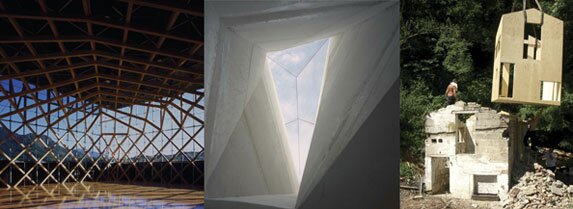

LIST OF ENTRANTS 2005
2004
winners 2004
2003
2002
2001
winners 2001
2000
winners 2000
1999
winners 1999
architectural review
Buro Happold
The prestigious Architectural Review Awards for Emerging Architecture 2005 were presented to winning architects and designers from all over the world on 6 December at the Royal Institute of British Architects (RIBA) in London. A distinguished international jury assessed hundreds of entries to find three award winners, seven high commendations, six commended schemes and eight honourable mentions.
The annual AR Awards are now seven years old and are recognised as the world's leading celebration of the work of young architects who are at the start of their independent careers and are often, as yet, not very well known. A very wide range of artefacts from over 50 countries was presented to the jury. They varied from furniture to landscape projects, churches to cocoons, and tiny pavilions to dramatic transformations of large existing buildings.
Jury criteria included sensitivity to genius loci, awareness of ecological implications, constructional ingenuity, sensitive understanding of materials, and inventiveness in handling space and light.
The three award winners are:
Taira Nishizawa for the Forestry Hall gymnasium in Tomochi, Kumamoto prefecture, Japan, which draws on the main local industry of forestry to create a lyrically arboreal timber and steel space frame structure. Its evident technical sophistication, thoughtful application of materials and response to local context deeply impressed the jurors.
Trahan Architects for an oratory in an educational campus in Louisiana, USA. This project had a different kind of architectural assurance distilled from a remarkably sensitive handling of space and light. Rigorously austere in its conception and execution, the little chapel is a potent and moving embodiment of the numinous.
FNP Architekten for a showroom in Pfalz, Germany. An eighteenth-century farm building is imaginatively transformed into a showroom by the simple expedient of placing a timber structure inside the original crumbling stone shell. Jurors applauded it for its economy of thought and clarity of execution. And, of course, its sheer wit.
Award winners share the £ prize money equally.
Highly commendedSeven projects were given high commendations. They range from Li Xiaodong's Yuhu Elementary School and Community Centre in remote Lijiang, China, which skilfully reinterprets traditional Chinese architectural forms, to K2S Architects' new grandstand roof on Helsinki's Olympic Stadium, which adds to a heroic landmark of Finnish Modernism. Three very different bridge projects were highly commended. Thomas Heatherwick Studio's kinetic Rolling Bridge in London's Paddington Basin and David Sheppard Architects' footbridge at St Austell in the Cornish countryside are both elegant feats of engineering in the best British tradition which make an intriguing contrast, both geographically and culturally, with a community-built bridge in Gansu province in China, designed by the Architecture Department at Hong Kong's Chinese University. In northern Portugal, a restaurant by the Porto-based partnership of António Portugal + Manuel Maria Reis celebrates the drama of a breathtaking rural landscape, while in Hokkaido, the most northerly island of the Japanese archipelago, a residential care unit for mentally disabled people by Sou Fujimoto Architects responds with great sensitivity to a challenging social programme.
Commended
Six entries were commended. Jurors were particularly encouraged to note that many winning submissions tackled briefs for marginalised or impoverished communities. Rural Studio's forest pavilion in Perry County, the poorest county of Alabama, provides a much-needed focus for community activities and Brendeland & Kristoffersen's housing in Trondheim accommodates artists and former squatters. The often extreme range of sites and climates prompted some intriguing architectural responses, from the Arctic wastes of Spitzbergen, where Jarmund Vigsnaes' research centre must cope with alarmingly intense snow blizzards, to Chile's Pacific coast, where a clifftop house by Pezo von Ellrichshausen is a simple but powerful abstract statement and constructed using very limited means. Some awkward building types were also successfully reworked, such as Zechner & Zechner's boldly sculptural air traffic control tower at Vienna airport and a car showroom in Nagoya by Shuhei Endo which employs corrugated metal panels with typical flair.
Honourable mentions
Eight schemes were given honourable mentions. In the tropical latitudes of Bali, Budi Pradono envelops a restaurant complex in a lightweight bamboo skin to filter light and air. In Ahmedabad, regional capital of Gujarat, Matharoo Associates' blood donation and collection centre is the largest of its kind in India and an impressive civic statement. In New York, LTL Architects' compact, metropolitan restaurant is enlivened by an extraordinary ceiling that resembles porcupine spines. On the edge of Zurich, Pool Architekten's public housing manifests surprising spatial variety and generosity, while Sou Fujimoto's radical, radial urban house in Maebashi City prompts new ways of thinking about domestic life. Fujimoto is one of the very few architects to be honoured by the awards programme twice in the same year, as are Barcelona-based ex.studio, which gained two honourable mentions, one for an extraordinary cocoon-type tree house and another for the riotously colourful Tambabox, an inventive temporary fabric installation inspired by the exuberance of Senegalese textiles. Another project that shared this offbeat spirit of intelligence and humour was the delightful urban balloon installation in a Vancouver alleyway by Satoshi Matsuoka and Yuki Tamura.Jury members were Luis Mansilla, of Madrid-based partnership Mansilla & Tuñon; Annette Gigon from Swiss practice Gigon/Guyer; Sean Godsell from Melbourne (a former AR Awards winner) and Peter Davey, former AR editor. Current AR editor Paul Finch was jury chairman.
All work submitted for the award scheme must be constructed. The age limit of 45 was chosen for entrants because in many countries architects and designers find it difficult to build before that age.
This year the awards are supported by Buro Happold, the outstanding multi-disciplinary international practice of consulting engineers with 12 offices worldwide. Further information and illustrations are available from Elspeth Wales, tel: , email:
For further information and images contact:
Susanne Guenther or Carolyn Larkin at Caro Communications, tel: , email:
Paul Finch at The Architectural Review, tel: , email:
An exhibition of winning entries is on show at the RIBA, 66 Portland Place, London, W1 from 7 December until 28 February 2006, as part of the RIBA Trust programme. Selected winners will also take part in the RIBA Trust 2006 Spring Lecture Series. Details to be confirmed. www.architecture.com